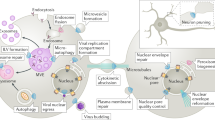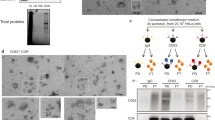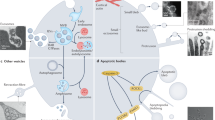Abstract
The careful sorting and recycling of membranes and cargo and the intracellular delivery of proteins, toxins and viruses by endocytosis are well-established roles for the endocytic apparatus, which is present in all eukaryotic cells. Recently, it has become clear that endosomes have key roles in such diverse processes as cytokinesis, polarization and migration, in which their functions might be distinct from those classically associated with endosomes. We speculate that endosomes function as multifunctional platforms on which unique sets of molecular machines are assembled to suit different cellular roles.
This is a preview of subscription content, access via your institution
Access options
Subscribe to this journal
Receive 12 print issues and online access
$189.00 per year
only $15.75 per issue
Buy this article
- Purchase on Springer Link
- Instant access to full article PDF
Prices may be subject to local taxes which are calculated during checkout


Similar content being viewed by others
References
Seaman, M. N. Endosome protein sorting: motifs and machinery. Cell. Mol. Life Sci. 65, 2842–2858 (2008).
Lemmon, S. K. & Traub, L. M. Sorting in the endosomal system in yeast and animal cells. Curr. Opin. Cell Biol. 12, 457–466 (2000).
Sönnichsen, B., De Renzis, S., Neilsen, E., Rietdorf, J. & Zerial, M. Distinct membrane domains on endosomes in the recycling pathway visualized by multicolor imaging of Rab4, Rab5, and Rab11. J. Cell Biol. 149, 901–914 (2000).
Christoforidis, S. et al. Phosphatidylinositol-3-OH kinases are Rab5 effectors. Nature Cell Biol. 1, 249–252 (1999).
Gaullier, J.-M. et al. FYVE fingers bind PtdIns(3)P. Nature 394, 432–433 (1998).
Miaczynska, M. & Zerial, M. Mosaic organization of the endocytic pathway. Exp. Cell Res. 272, 8–14 (2002).
Emery, G. & Knoblich, J. A. Endosome dynamics during development. Curr. Opin. Cell Biol. 18, 407–415 (2006).
Miaczynska, M., Pelkmans, L. & Zerial, M. Not just a sink: endosomes in control of signal transduction. Curr. Opin. Cell Biol. 16, 400–406 (2004).
Sorkin, A. & von Zastrow, M. Signal transduction and endocytosis: close encounters of many kinds. Nature Rev. Mol. Cell Biol. 3, 600–614 (2002).
Barr, F. A. & Gruneberg, U. Cytokinesis: placing and making the final cut. Cell 131, 847–860 (2007).
Glotzer, M. The molecular requirements for cytokinesis. Science 307, 1735–1739 (2005).
Albertson, R., Riggs, B. & Sullivan, W. Membrane traffic: a driving force in cytokinesis. Trends Cell Biol. 15, 92–101 (2005).
Gromley, A. et al. Centriolin anchoring of exocyst and SNARE complexes at the midbody is required for secretory-vesicle-mediated abscission. Cell 123, 75–87 (2005).
Goss, J. W. & Toomre, D. K. Both daughter cells traffic and exocytose membrane at the cleavage furrow during mammalian cytokinesis. J. Cell Biol. 181, 1047–1054 (2008).
Fielding, A. B. et al. Rab11–FIP3 and FIP4 interact with Arf6 and the exocyst to control membrane traffic in cytokinesis. EMBO J. 24, 3389–3399 (2005).
Kouranti, I., Sachse, M., Arouche, N., Goud, B. & Echard, A. Rab35 regulates an endocytic recycling pathway essential for the terminal steps of cytokinesis. Curr. Biol. 16, 1719–1725 (2006).
Desautels, M., Den Haese, J. P., Slupsky, C. M., McIntosh, L. P. & Hemmingsen, S. M. Cdc4p, a contractile ring protein essential for cytokinesis in Schizosaccharomyces pombe, interacts with a phosphatidylinositol 4-kinase. J. Biol. Chem. 276, 5932–5942 (2001).
Emoto, K., Inadome, H., Kanaho, Y., Narumiya, S. & Umeda, M. Local change in phospholipid composition at the cleavage furrow is essential for completion of cytokinesis. J. Biol. Chem. 280, 37901–37907 (2005).
Field, S. J. et al. PtdIns(4,5)P2 functions at the cleavage furrow during cytokinesis. Curr. Biol. 15, 1407–1412 (2005).
Janetpopoulos, C., Borleis, J., Vazquez, F., Iijima, M. & Devreotes, P. Temporal and spatial regulation of phosphoinositide signaling mediates cytokinesis. Dev. Cell 8, 467–477 (2005).
Pohl, C. & Jentsch, S. Final stages of cytokinesis and midbody ring formation are controlled by BRUCE. Cell 132, 832–845 (2008).
Carlton, J. G. & Martin-Serrano, J. Parallels between cytokinesis and retroviral budding: a role for the ESCRT machinery. Science 316, 1908–1912 (2007).
Morita, E. et al. Human ESCRT and ALIX proteins interact with proteins of the midbody and function in cytokinesis. EMBO J. 26, 4215–4227 (2007).
Hanson, P. I., Roth, R., Lin, Y. & Heuser, J. E. Plasma membrane deformation by circular arrays of ESCRT-III protein filaments. J. Cell Biol. 180, 389–402 (2008).
Dukes, J. D., Richardson, J. D., Simmons, R. & Whitley, P. A dominant-negative ESCRT-III protein perturbs cytokinesis and trafficking to lysosomes. Biochem. J. 411, 233–239 (2008).
Lee, H. H., Elia, N., Ghirlando, R., Lippincott-Schwartz, J. & Hurley, J. H. Midbody targeting of the ESCRT machinery by a noncanonical coiled coil in CEP55. Science 322, 576–580 (2008).
Yang, D. et al. Structural basis for midbody targeting of spastin by the ESCRT-III protein CHMP1B. Nature Struct. Mol. Biol. 15, 1278–1286 (2008).
Boucrot, E. & Kirchhausen, T. Endosomal recycling controls plasma membrane area during mitosis. Proc. Natl Acad. Sci. USA 104, 7939–7944 (2007).
Giansanti, M. G., Belloni, G. & Gatti, M. Rab11 is required for membrane trafficking and actomyosin ring constriction in meiotic cytokinesis of Drosophila males. Mol. Biol. Cell 18, 5034–5047 (2007).
Sommer, B., Oprins, A., Rabouille, C. & Munro, S. The exocyst component Sec5 is present on endocytic vesicles in the oocyte of Drosophila melanogaster. J. Cell Biol. 169, 953–963 (2005).
Langevin, J. et al. Drosophila exocyst components Sec5, Sec6, and Sec15 regulate DE-cadherin trafficking from recycling endosomes to the plasma membrane. Dev. Cell 9, 365–376 (2005).
Deborde, S. et al. Clathrin is a key regulator of basolateral polarity. Nature 452, 719–725 (2008).
Nance, J. PAR proteins and the establishment of cell polarity during C. elegans development. Bioessays 27, 126–135 (2005).
Balklava, Z., Pant, S., Fares, H. & Grant, B. D. Genome-wide analysis identifies a general requirement for polarity proteins in endocytic traffic. Nature Cell Biol. 9, 1066–1073 (2007).
Moberg, K. H., Schelble, S., Burdick, S. K. & Hariharan, I. K. Mutations in erupted, the Drosophila ortholog of mammalian tumor susceptibility gene 101, elicit non-cell-autonomous overgrowth. Dev. Cell 9, 699–710 (2005).
Thompson, B. J. et al. Tumor suppressor properties of the ESCRT-II complex component Vps25 in Drosophila. Dev. Cell 9, 711–720 (2005).
Vaccari, T. & Bilder, D. The Drosophila tumor suppressor vps25 prevents nonautonomous overproliferation by regulating notch trafficking. Dev. Cell 9, 687–698 (2005).
Gillette, J. M., Larochelle, A., Dunbar, C. E. & Lippincott-Schwartz, J. Intercellular transfer to signalling endosomes regulates an ex vivo bone marrow niche. Nature Cell Biol. 8 Feb 2009 (doi: 10.1038/ncb1838).
Webb, D. J., Parsons, J. T. & Horwitz, A. F. Adhesion assembly, disassembly and turnover in migrating cells — over and over and over again. Nature Cell Biol. 4, E97–E100 (2002).
Sturge, J., Wienke, D. & Isacke, C. M. Endosomes generate localized Rho–ROCK–MLC2-based contractile signals via Endo180 to promote adhesion disassembly. J. Cell Biol. 175, 337–347 (2006).
Witze, E. S., Litman, E. S., Argast, G. M., Moon, R. T. & Ahn, N. G. Wnt5a control of cell polarity and directional movement by polarized redistribution of adhesion receptors. Science 320, 365–369 (2008).
Machesky, L. M. Lamellipodia and filopodia in metastasis and invasion. FEBS Lett. 582, 2102–2011 (2008).
Palamidessi, A. et al. Endocytic trafficking of Rac is required for the spatial restriction of signaling in cell migration. Cell 134, 135–147 (2008).
Olivotto, M., Arcangeli, A., Carlà, M. & Wanke, E. Electric fields at the plasma membrane level: a neglected element in the mechanisms of cell signalling. Bioessays 18, 495–504 (1996).
Yeung, T. et al. Receptor activation alters inner surface potential during phagocytosis. Science 313, 347–351 (2006).
Yeung, T. et al. Membrane phosphatidylserine regulates surface charge and protein localization. Science 319, 210–213 (2008).
Bonifacino, J. S. & Glick, B. S. The mechanisms of vesicle budding and fusion. Cell 116, 153–166 (2004).
Mayor, S. & Pagano, R. E. Pathways of clathrin-independent endocytosis. Nature Rev. Mol. Cell Biol. 8, 603–612 (2007).
Hurley, J. H. & Emr, S. D. The ESCRT complexes: structure and mechanism of a membrane-trafficking network. Annu. Rev. Biophys. Biomol. Struct. 35, 277–298 (2006).
Schütze, S., Tchikov, V. & Schneider-Brachret, W. Regulation of TNFR1 and CD95 signalling by receptor compartmentalization. Nature Rev. Mol. Cell Biol. 9, 655–662 (2008).
Acknowledgements
Work in the G.W.G. laboratory is supported by grants from the Wellcome Trust and the Biotechnology and Biological Sciences Research Council, Cancer Research UK and the Association for International Cancer Research. G.W.G. thanks C. Isacke and N. Bryant for helpful comments on the manuscript.
Author information
Authors and Affiliations
Related links
Rights and permissions
About this article
Cite this article
Gould, G., Lippincott-Schwartz, J. New roles for endosomes: from vesicular carriers to multi-purpose platforms. Nat Rev Mol Cell Biol 10, 287–292 (2009). https://doi.org/10.1038/nrm2652
Published:
Issue Date:
DOI: https://doi.org/10.1038/nrm2652
This article is cited by
-
Selective eradication of human non-small cell lung cancer cells using aptamer-decorated nanoparticles harboring a cytotoxic drug cargo
Cell Death & Disease (2019)
-
Local T regulatory cells depletion by an integrated nanodrug system for efficient chem-immunotherapy of tumor
Science China Chemistry (2019)
-
Expression profiling and intracellular localization studies of the novel Proline-, Histidine-, and Glycine-rich protein 1 suggest an essential role in gastro-intestinal epithelium and a potential clinical application in colorectal cancer diagnostics
BMC Gastroenterology (2018)
-
Circulating exosomes and exosomal microRNAs as biomarkers in gastrointestinal cancer
Cancer Gene Therapy (2017)
-
Functions of Cancer-Derived Extracellular Vesicles in Immunosuppression
Archivum Immunologiae et Therapiae Experimentalis (2017)



